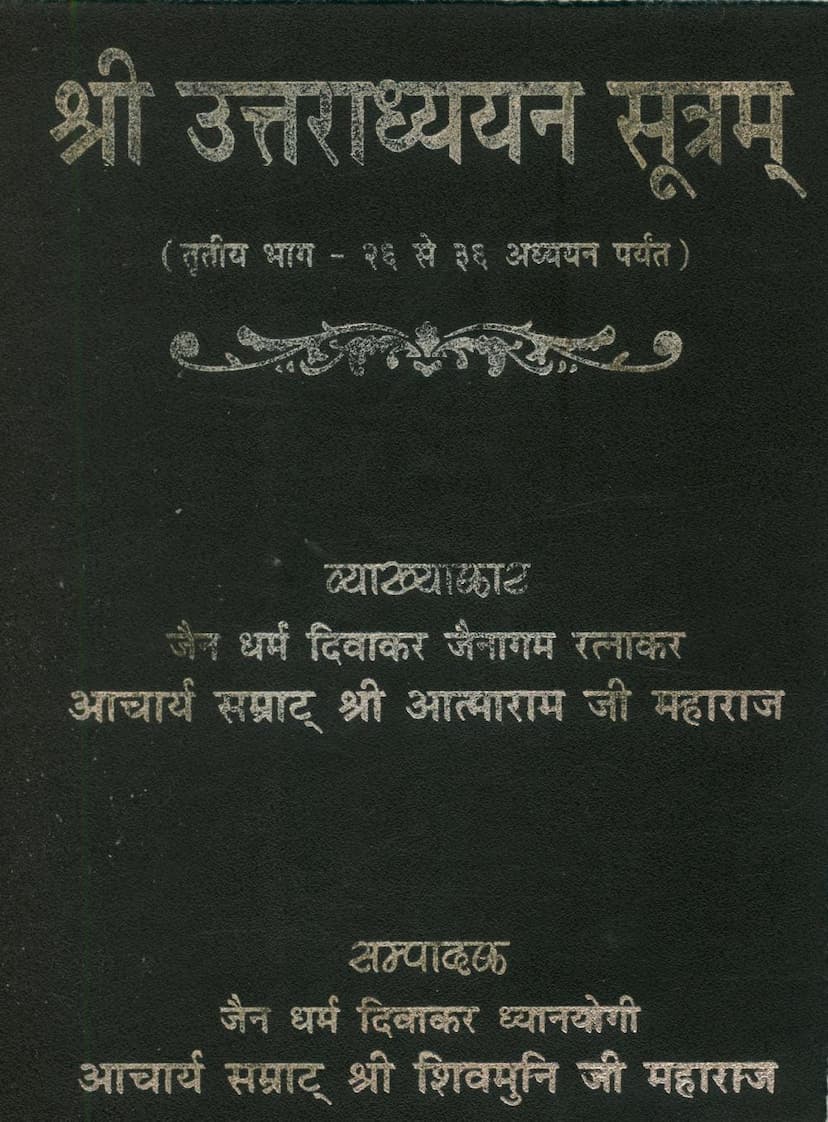Uttaradhyayan Sutram Part 03
Added to library: September 2, 2025

Summary
This detailed summary of the Uttaradhyayan Sutram, Part 03, covers chapters 26 through 36, drawing from the commentary by Acharya Samrat Shri Atmaramji Maharaj and edited by Acharya Samrat Shri Shiv Muni Ji Maharaj. The text delves into profound Jain philosophical concepts, focusing on conduct, self-control, and the path to liberation.
Key Themes and Concepts:
- Samayachari (Conduct): The Uttaradhyayan Sutram places immense importance on proper conduct for monks. Chapter 26, "Ah Samayari Chhavvisaimam Ajjhayanam" (Samayachari), meticulously outlines the ten essential aspects of a monk's daily conduct, including seeking permission, proper entry and exit from residences, seeking guidance, self-reflection, and respectful interaction with seniors and peers. These practices are presented as crucial for spiritual progress and the eradication of suffering.
- Self-Reliance and Inner Strength: Acharya Shiv Muni's editorial commentary, particularly in the section titled "Nirbhik Atmarathi Evam Panchachar Ki Pratmurti: Acharya Samrat Shri Shiv Muni Ji M.", emphasizes the paramount importance of self-reliance and inner strength (Atma-bal). External forces or dependencies are seen as detrimental to true strength, which arises from spiritual discipline, truth, and non-violence.
- The Nature of Virtue and Vice: The text contrasts concepts like restraint (Sanyam) and lack of restraint (Asanyam), highlighting how attachment to sensory pleasures fuels the cycle of non-restraint and leads to sinful actions. Conversely, the control of senses and the pursuit of righteousness are portrayed as the path to liberation.
- The Fivefold Conduct (Panchachar): Acharya Shiv Muni's commentary also explains the "Panchachar," the five cardinal practices that are central to Jain spiritual life:
- Jnanaachar (Conduct of Knowledge): Emphasizes acquiring and practicing true knowledge from the scriptures and through self-realization.
- Darshanachar (Conduct of Perception/Faith): Focuses on right faith and unwavering devotion to the Tirthankaras and the Jain path.
- Charitraachar (Conduct of Practice): Refers to the disciplined adherence to the vows and code of conduct for ascetics.
- Tapachar (Conduct of Austerities): Highlights the significance of internal and external austerities in purifying the soul and burning karmas.
- Viryachar (Conduct of Energy/Effort): Stresses the importance of continuous and dedicated spiritual effort and perseverance.
- The Path to Liberation (Moksha): Chapters 27 ("Ah Khlun Kiyain Sattavisam Adhyayanam" - Khlun Kiyain), 28 ("Ah Moksh Marggati Attavisam Adhyayanam" - Mokshamargagati), and 30 ("Ah Tavamargam Trisam Adhyayanam" - Tavamargam) are dedicated to understanding the path to liberation. Chapter 27 critiques "Shathata" (deceitfulness) and emphasizes "Ashathata" (sincerity) and self-control, using the analogy of a disciplined bullock controlled by a driver. Chapter 28 details the four essential components of the path to liberation: Right Knowledge (Jnana), Right Perception (Darshan), Right Conduct (Charitra), and Right Austerity (Tapas). Chapter 30 delves into the practice of austerities (Tapas) as a means to shed karmas and achieve purification.
- The Cycle of Karma: The text, particularly Chapter 33 ("Ah Karmaprakrti Trisatrisam Adhyayanam" - Karmaprakrti), explains the eight fundamental types of karmas (Jnana-avaraniya, Darshan-avaraniya, Vedaniya, Mohaniya, Ayushkarma, Namakarma, Gotrakarma, and Antaraya Karma) and their profound impact on the soul's journey through samsara. It details their subtle workings and how they bind the soul to the cycle of birth and death.
- The Six Lésyás (Subtle Passions): Chapter 34 ("Ah Lésyādhyayanam Nam Chaturtrinśatam Adhyayanam" - Lésyādhyayanam) explains the six subtle states of the soul (Lésyás) – Krishna (black), Nila (blue), Kapota (dove-colored), Tejo (fiery), Padma (lotus-colored), and Shukla (white). It describes their characteristics, colors, tastes, smells, touches, and the types of beings who predominantly exhibit them, emphasizing how these Lésyás influence one's destiny and spiritual state.
- The Importance of Renunciation (Anagar): Chapter 35 ("Ah Anagaradhyayanam Nam Panchatrinśatam Adhyayanam" - Anagaradhyayanam) focuses on the virtues and practices of an Anagar (ascetic). It details the qualities of a true ascetic, including non-attachment, self-control, purity of conduct, and the importance of living in solitude or pure environments. It contrasts the consequences of attachment with the liberation achieved through detachment.
- The Sixfold Classification of Souls (Jiva and Ajiva): Chapter 36 ("Ah Jivajivavibhhati Nam Shattrinśatam Adhyayanam" - Jivajivavibhhati) systematically classifies souls and non-soul entities (Ajiva). It elaborates on the categories of Jivas (souls) such as Jivas with one to five senses and the five types of Ajiva entities (Dharmastikaya, Adharmastikaya, Akashastikaya, Kalastikaya, and Pudgalastikaya), explaining their characteristics, locations, and states of existence. This chapter serves as a foundational text for understanding the fundamental constituents of the universe in Jain philosophy.
Overall Message:
The Uttaradhyayan Sutram, Part 03, in its entirety, serves as a comprehensive guide for spiritual aspirants, particularly monks, on the path of renunciation and self-realization. It meticulously details the ethical conduct, spiritual practices, and philosophical understanding necessary to transcend worldly suffering and achieve ultimate liberation (Moksha). The commentary by Acharya Atmaramji Maharaj and the editing by Acharya Shiv Muni Ji Maharaj provide invaluable insights, making these ancient teachings accessible and relevant for contemporary readers. The text underscores the interconnectedness of actions, karmic consequences, and the soul's potential for spiritual evolution.